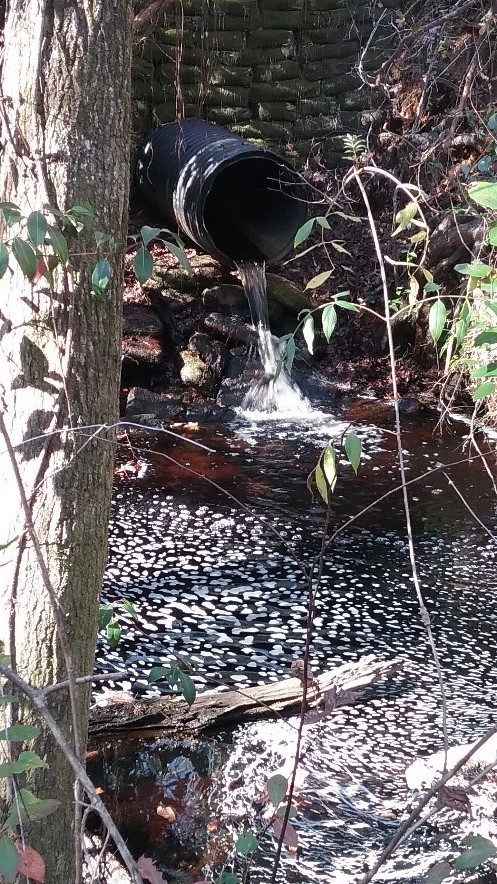
by Andrea Albertin | Mar 11, 2017
Stormwater runoff is water from rainfall that flows along the land surface. This runoff usually finds its way into the nearest ditch or water body, such as a river, stream, lake or pond. Generally speaking, in natural undeveloped areas only 10% of rainfall is runoff. About 40% returns to the atmosphere though evapotranspiration, which is the water evaporated from land and plant surfaces plus water lost directly from plants to the atmosphere through their leaves. The remaining 50% of rainfall soaks into the ground, supporting vegetation, contributing to streamflow and replenishing groundwater resources. In Florida, where 90% of the population relies on groundwater for their drinking water, aquifer recharge from infiltrating rainwater is vital.
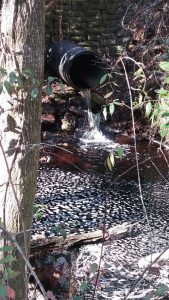
Stormwater runoff from a drainage pipe flowing into a creek.
Photo: Andrea Albertin
As landscapes become more developed, areas that use to absorb rainwater are replaced by impervious surfaces like rooftops, driveways, parking lots and roads. Additionally, we are levelling our land, removing natural depressions in the landscape that trap rainwater and give it time to seep back into the ground. As a result, a higher percentage of rainfall is becoming runoff and which flow at faster rates into storm drainages and nearby water bodies instead of soaking into the soil.
A major problem with stormwater runoff is that as it flows over surfaces, it picks up potential pollutants that end up in our waterways. These include trash, sediment, fertilizer and pesticides from lawns, bacteria from dog waste, metals from rooftops, and oil from parking lots and roads. Stormwater runoff is often the main cause of surface water pollution in urban areas.
Luckily, there are ways in which we can all help slow the flow and reduce stormwater runoff. These reductions can give rainfall more time to soak back into the ground and replenish our needed stores of groundwater.
What can you do to help “slow the flow” of stormwater?
The UF/IFAS Florida Friendly Landscaping Program provides the following recommendations that you, as a homeowner, can do to reduce stormwater runoff from your property:
- Direct your downspouts and gutters to drain onto the lawn, plant beds, or containment areas, so that rain soaks into the soil instead of running off the yard.
- Use mulch, bricks, flagstone, gravel, or other porous surfaces for walkways, patios, and drives.
- Reduce soil erosion by planting groundcovers on exposed soil such as under trees or on steep slopes
- Collect and store runoff from your roof in a rain barrel or cistern.
- Create swales (low areas), rain gardens or terracing on your property to catch, hold, and filter stormwater.
- Pick up after your pets.
- Clean up oil spills and leaks on the driveway. Instead of using soap and water, spread cat litter over oil, sweep it up and then throw away in the trash.
- Sweep grass clippings, fertilizer, and soil from driveways and streets back onto the lawn. Remove trash from street gutters before it washes into storm drains. The City of Tallahassee’s TAPP (Think About Personal Pollution) Campaign is another excellent resource for ways in which you can help reduce stormwater runoff (http://www.tappwater.org/).
- For more information on stormwater management on your property and other Florida Friendly Landscaping principles, you can visit the Florida Friendly Landscaping website at: https://ffl.ifas.ufl.edu.
TAPP also provides a manual for homeowners on how to build a raingarden, which can be found at http://tappwaterapp.com/what-can-i-do/build-a-rain-garden/. Raingardens are small depressions (either naturally occurring or created) that are planted with native plants. They are designed to temporarily catch rainwater, giving it time to slowly soak back into the ground.
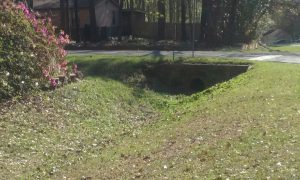
Grass covered drainage ditches slow the flow of stormwater runoff and allow more rainwater to soak back into the ground.
Photo: Andrea Albertin
by Carrie Stevenson | Mar 3, 2017
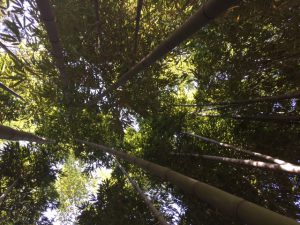
Bamboo shoots can grow as tall as 70 feet. Photo credit: Carrie Stevenson
Standing in the midst of a stand of bamboo, it’s easy to feel dwarfed. Smooth and sturdy, the hollow, sectioned woody shoots of this fascinating plant can tower as tall as 70 feet. Unfortunately, bamboo is a real threat to natural ecosystems, moving quickly through wooded areas, wetlands, and neighborhoods, taking out native species as it goes.
We do have one native species referred to as bamboo or cane (Arundinaria gigantea), which is found in reasonable numbers in southeastern wetlands and the banks of rivers. There are over a thousand species of true bamboo, but chief among the invasive varieties that give us trouble is Golden Bamboo (Phyllostachys aurea). Grown in its native Southeast Asia as a food source, building material, or for fishing rods, bamboo is also well known as the primary diet (99%) of the giant panda. In the United States, the plant was brought in as an ornamental—a fast growing vegetative screen that can also be used as flooring material or food. Clumping bamboos can be managed in a landscape, but the invasive, spreading bamboo will grow aggressively via roots and an extensive network of underground rhizomes that might extend more than 100 feet from their origin.
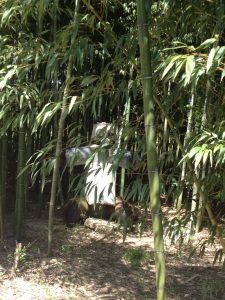
Whimsy art Panda in a bamboo forest at the Glendale Nature Preserve. Photo credit: Carrie Stevenson
As a perennial grass, bamboo grows straight up, quickly, and can withstand occasional cutting and mowing without impacts to its overall health. However, a repeated program of intensive mowing, as often as you’d mow a lawn and over several years, will be needed to keep the plant under control. Small patches can be dug up, and there has been some success with containing the rhizomes by installing an underground “wall” of wood, plastic, or metal 18” into the soil around a section of bamboo.
While there are currently no chemical methods of control specifically labeled for bamboo at this time, the herbicides imazapyr (trade name Arsenal and others) or glyphosate (Round-up, Rodeo) applied at high rates can control it. According to research on the topic, “bamboo should be mowed or chopped and allowed to regrow to a height of approximately 3 feet, or until the leaves expand. Glyphosate at a 5% solution or imazapyr as a 1% solution can then be applied directly to the leaves.” These treatments will often need to be repeated as many as four times before succeeding in complete control of bamboo.
Land managers should know that while imazapyr is typically a more effective herbicide for bamboo, it can kill surrounding beneficial trees and shrubs due to its persistence in the contiguous roots and soil. In contrast, glyphosate solutions will only kill the species to which it has been applied and is the best choice for most areas managed by homeowners.
Bamboo Control Publication
by Jennifer Bearden | Mar 3, 2017
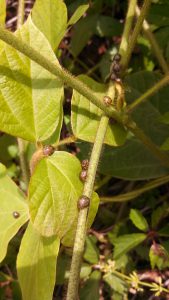
Kudzu bugs on soybeans. Photo credit: Jennifer Bearden
A few years ago, Florida is extended a warm welcome to a new pest – The Kudzu Bug! The kudzu bug was first documented in the US in 2009 in Northeast Georgia. It has quickly spread throughout the southeast.
At first, a pest that attacks kudzu sounds pretty good but this bug also attacks wisteria, figs, and other legumes like beans and peas. It is a serious pest to soybeans that are grown in our area. They are similar to stink bugs and discharge an odor when disturbed. Skin and eye irritation can occur from this odor emission.
Kudzu bugs are small (3.5-6mm long), and are rounded oblong in shape, and olive-green in color. They lay egg masses in two rows of 13 to 137 eggs per row. The first generation of kudzu bugs seem to prefer to feed on kudzu but subsequent generations will feed on and lay eggs on other legumes. When fall comes, the adults over-winter where they can find shelter. They crawl under tree bark and into cracks in houses.
If kudzu bugs make their way into your home, you can vacuum them up and dispose of them. If they are in your landscape or garden, you can set up a trap using a bucket of soapy water and a piece of white poster board. Kudzu bugs are attracted to lighter colors. To make the trap, cut the poster board in half. Attach the two halves by cutting a line up the middle of the two pieces and inserting them into each other. They should be in the shape of a plus sign. Place the board over the bucket of soapy water. As the insects hit the board, they will fall into the soapy water and drown.
Insecticides can be used but timing and placement are very important. Right now, kudzu bugs are just becoming active making now a good time to spray kudzu host plants with an insecticide. Insecticide with active ingredients ending in “-thrin”, such as pyrethrin, cyfluthrin, etc., are effective against kudzu bugs. Always read and follow label directions and precautions when using any pesticide. Controlling kudzu near your house will help decrease the number of bugs, but they are strong flyers and can migrate through neighborhoods that aren’t near kudzu.
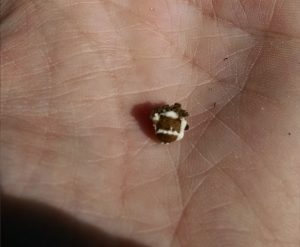
Kudzu bug infected with Beauveria bassiana. Photo credit: Jennifer Bearden
There are some natural enemies of kudzu bugs! Generalist predators like green lacewings, lady beetles, damsel bugs and big eye bugs will attack kudzu bug nymphs. There are also two parasitoids that attack them. Both discovered in 2013, there is a tiny wasp that develops in the kudzu bug eggs and a fly that lays its eggs in the adult kudzu bug. The Kudzu bug, like other exotic invasive insect, are opportunistic and we have yet to see how many different plants species may serve as a host for this pest. Beauveria bassiana has also been found to infect kudzu bugs and seem to be an effective natural enemy.
For more information on the kudzu bug, contact the UF/IFAS Extension Office in your county.
by Carrie Stevenson | Mar 2, 2017
Guest Blogger – Dr. Steve A. Johnson, Associate Professor & Extension Specialist, Department of Wildlife Ecology and Conservation, University of Florida
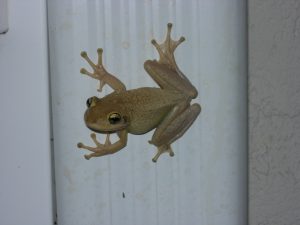
Cuban Treefrog. Photo credit: Steve Johnson
The National Invasive Species Council defines an invasive species as one that is introduced outside its native range where it causes harm (or is likely to) to the environment, economy, or human quality of life. The Cuban Treefrog in Florida qualifies as invasive under all three parts of this definition. Introduced from Cuba to Key West inadvertently in a shipment of cargo about 100 years ago, this frog is now established throughout Florida’s peninsula, and isolated records from numerous panhandle counties continue to accumulate. There are many records of Cuban Treefrogs from other states in the US, and even Canada. Most of these frogs originated in Florida and found their way to points beyond as hitchhikers on vehicles or as stowaways in shipments of ornamental plants. Fortunately, Cuban Treefrogs do not appear to have gained a permanent foothold—yet—outside of the Sunshine State.
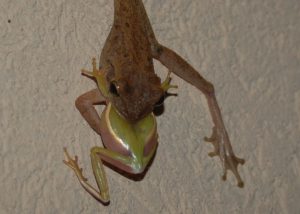
Cuban Treefrog eating a Green Treefrog. Photo Credit: Nancy Bennett
Cuban Treefrogs are well documented predators of Florida’s native treefrogs and are likely responsible for declines in native treefrog numbers, especially in suburban neighborhoods. Fortunately, research has shown that when native frogs (e.g., Squirrel and Green Treefrogs) are still present that they respond favorably to the removal of their invasive cousins. Cuban Treefrogs are known to seek shelter in electrical utility equipment or even a home air-conditioning units, and as they climb around they may cause short circuits, leading to costly repairs. They also invade homes, ending up in a toilet at times, and have also sent young children to the emergency room. The frogs exude a noxious skin secretion when handled, which is extremely irritating to mucous membranes, especially one’s eyes. So be sure to wash your hands thoroughly after handling a Cuban Treefrog.
To mitigate the negative impacts Cuban Treefrogs are having on Florida’s native wildlife, as well as their effects on our quality of life, I recommend that these invaders be captured and humanely euthanized. For tips on how to capture, identify, and humanely euthanize these frogs visit http://ufwildlife.ifas.ufl.edu/ and also read “The Cuban Treefrog in Florida”. Report sightings of this species outside of the Florida peninsula to Dr. Steve A. Johnson, and within the peninsula report them on EDDmapS.
by Rick O'Connor | Mar 2, 2017
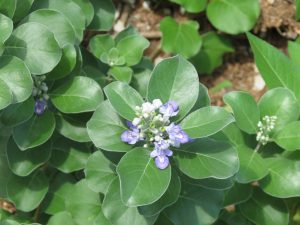
Beach Vitex Blossom. Photo credit: Rick O’Connor
Research shows that the most effective time to deal with an invasive species, both in terms of controlling or eradicating the species and money spent to do so, is early on…. What we call Early Detection Rapid Response. Beach vitex is a good candidate for this.
The first record for vitex in the Florida panhandle was in 2012. A local citizen in Gulf Breeze (Santa Rosa County) reported it on her beach and believed it may have come from Santa Rosa Island… it did. The barrier island location was logged on EDDmaps and the Gulf Breeze plants were removed. A quick survey of Florida on EDDmaps found that the only other location was in Duval County – 3 records there. So this was not a wide spread plant in our state and could be a rare case for eradication. That was until I surveyed Pensacola Beach on a bicycle and found 22 properties with it. Soon afterwards, it was found on the shores of Perdido Bay and concern set it that it might be more widespread than we thought.
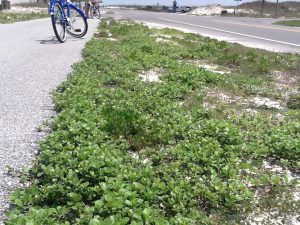
Vitex beginning to take over bike path on Pensacola Beach. Photo credit: Rick O’Connor
We tried to educate the property owners about the issue based on what we learned in South Carolina, where there is a state task force to battle the plant, and suggested methods of removal. Many property owners began the process, which can take several treatments over several years, and, with the help of University of West Florida students, removed all of the vitex from public land on Santa Rosa Island. We were feeling good that we might still be able to eradicate this plant from our county… and then I went for a hike in the Gulf Islands National Seashore… yep… found more… almost 10,000 m2 of the plant. UWF and Sea Grant have worked hard over the past year to remove these plants, and have removed all but one section. Recently I received an email letting me know that it was found in Franklin County. They have since logged this on EDDmaps and have begun the removal process. However, this begs the question… where else might this plant be in the panhandle?
Beach vitex (Vitex rotundifolia) is a salt tolerant plant that does well in dry sandy soils and full sun; it loves the beach. We have found it in dune areas above the high tide line. It was brought to the United States in the 1950’s for herbarium use. By the 1980,’s the plant was used in landscaping and sold at nurseries. It was first used in dune restoration in South Carolina after Hurricane Hugo, and that was when the trouble began.
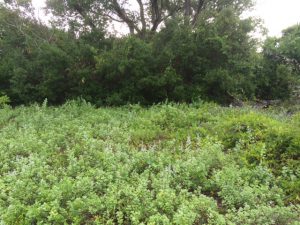
Vitex growing at Gulf Islands National Seashore that has been removed. Photo credit: Rick O’Connor
The plant grows very aggressively during the warmer months. It out competes native dune plants and quickly takes over. Growing 2-3 foot tall, this woody shrub has above ground rhizomes that can extend over 20 feet. Secondary roots begin to grow from the nodes along these rhizomes and it quickly forms an entangled mat of vines that blocks sun for some of the native plants. There has also been concern for nesting sea turtles. The rhizomes can over take a nest while incubation is occurring and entrapping the hatchlings. The plant has become such a problem in both North and South Carolina that a state task force has been developed to battle it. Vitex can spread either vegetative or by seed, both can tolerate being in salt water and can be dispersed via tides and currents. The plant has 1-2” ovate leaves and violet colored blossom, which can be seen in late spring and summer. The leaves become a rusty gray color during winter. The seeds, which are found in late summer and fall, are spherical and gray-purple in color. Vitex produces many seeds, an estimated 22,000/m2, and – in addition to being carried by the tide – can be transported by birds as well.
Again, we are hoping that the plant has been discovered early enough to control, if not eradicate, it… HOWEVER, WE NEED YOUR HELP. If you think you may have seen this plant along your coasts, please contact your county Sea Grant Extension Agent for advice on how to manage it.












